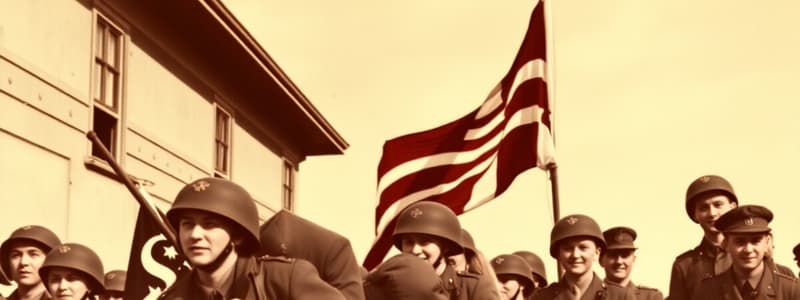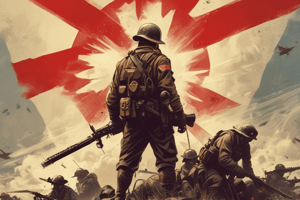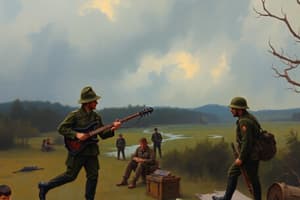Podcast
Questions and Answers
What was the name of the organization that fought for compensation for Japanese Americans after World War II?
What was the name of the organization that fought for compensation for Japanese Americans after World War II?
- A. Philip Randolph Labor Union
- Japanese American Citizen League (JACL) (correct)
- Congress of Racial Equality (CORE)
- Zoot Suit Riot Committee
What was the primary reason given by the Supreme Court in the Korematsu v. United States case for upholding the forced relocation of Japanese Americans?
What was the primary reason given by the Supreme Court in the Korematsu v. United States case for upholding the forced relocation of Japanese Americans?
- The desire to prevent the spread of Japanese culture
- The necessity to protect national security (correct)
- The government's fear of Japanese Americans collaborating with the enemy
- The need to ensure the safety of other citizens
What was the name of the executive order that authorized the forced relocation of Japanese Americans?
What was the name of the executive order that authorized the forced relocation of Japanese Americans?
- Executive Order 10352
- Executive Order 9066 (correct)
- Executive Order 9388
- Executive Order 8802
Who founded the Congress of Racial Equality (CORE) to fight segregation?
Who founded the Congress of Racial Equality (CORE) to fight segregation?
What percentage of Japanese Americans forced into internment camps were Nisei?
What percentage of Japanese Americans forced into internment camps were Nisei?
What was the primary motive for Americans joining the war effort following Pearl Harbor?
What was the primary motive for Americans joining the war effort following Pearl Harbor?
Which of the following government agencies was responsible for controlling the allocation of resources to the war effort?
Which of the following government agencies was responsible for controlling the allocation of resources to the war effort?
How did the American working class benefit from the war effort?
How did the American working class benefit from the war effort?
What initiative was implemented to help pace consumption during wartime?
What initiative was implemented to help pace consumption during wartime?
Which group faced significant challenges during the war due to racial discrimination and limited opportunities?
Which group faced significant challenges during the war due to racial discrimination and limited opportunities?
What role did women play in supporting the war effort?
What role did women play in supporting the war effort?
How did the government influence the American economy during the war?
How did the government influence the American economy during the war?
Which group contributed significantly to the war effort through their code-breaking skills?
Which group contributed significantly to the war effort through their code-breaking skills?
Flashcards
CORE
CORE
Congress of Racial Equality, a civil rights organization formed by James Farmer to fight segregation.
Japanese Internment
Japanese Internment
The forced relocation of Japanese Americans to camps during WWII due to fear of espionage.
Korematsu v. US (1944)
Korematsu v. US (1944)
Supreme Court case that justified Japanese internment based on 'military necessity.'
Executive Order 9066
Executive Order 9066
Signup and view all the flashcards
JACL
JACL
Signup and view all the flashcards
Selective Service Act
Selective Service Act
Signup and view all the flashcards
Women's Auxiliary Army Corps (WAAC)
Women's Auxiliary Army Corps (WAAC)
Signup and view all the flashcards
Rationing
Rationing
Signup and view all the flashcards
National War Labor Board (NWLB)
National War Labor Board (NWLB)
Signup and view all the flashcards
Navajo Codetalkers
Navajo Codetalkers
Signup and view all the flashcards
War Production Board (WPB)
War Production Board (WPB)
Signup and view all the flashcards
Victory Gardens
Victory Gardens
Signup and view all the flashcards
War Bonds
War Bonds
Signup and view all the flashcards
Study Notes
The Home Front: Wartime Propaganda
- 5 million rushed to enlist in the military, with the selective service act drafting a further 10 million.
- Women served in non-combat roles, freeing men for combat.
- Women's Auxiliary Army Corps (WAAC) allowed women to enlist as nurses, drivers, electricians, etc.
- Women Airforce Service Pilots (WASPs) and Women Accepted for Voluntary Emergency Service (WAVES) tested and delivered aircraft, and provided medical assistance.
- "Remember Pearl Harbor" was a rallying cry and a call for sacrifices.
- African Americans served in segregated units in non-combat roles until 1943.
- Asian Americans also served in the military, and some also as spies.
- Mexican and Native Americans also contributed to the war effort.
- Minorities faced dilemmas regarding their role in the war.
Industrial Production
- Wartime manufacturing dramatically changed, replacing consumer goods with war materials.
- The government took control of the economy through agencies like the Office of Price Administration (OPA) and War Production Board (WPB).
- Priorities were established, allocating resources for the war effort.
- Scrap drives and recycling programs were crucial.
- National War Labor Board (NWLB) managed wages, and rationing was implemented through coupons.
- Social and economic benefits were achieved for the working class, with unemployment dropping significantly and wages increasing.
Minorities in Military
- African Americans served in segregated units until 1943.
- Asian Americans faced distrust but still played a role in combat and other important positions.
- Mexican Americans and Native Americans also contributed.
Minorities faced dilemmas regarding their roles in the war effort.
Social and Economic Gains During the War
- Unemployment dropped significantly by 1944, and wages increased by 10%.
- Improved farming techniques and increased demand boosted profits.
- Women made up a significant portion of the workforce, taking on more jobs.
- War bonds were a way to save money.
Studying That Suits You
Use AI to generate personalized quizzes and flashcards to suit your learning preferences.




